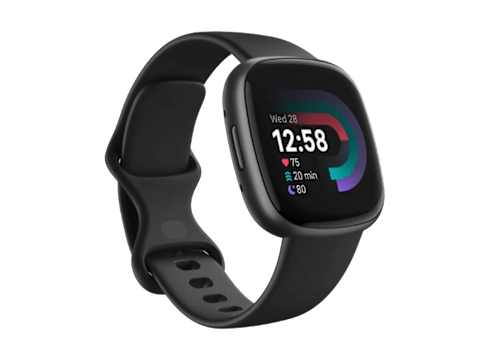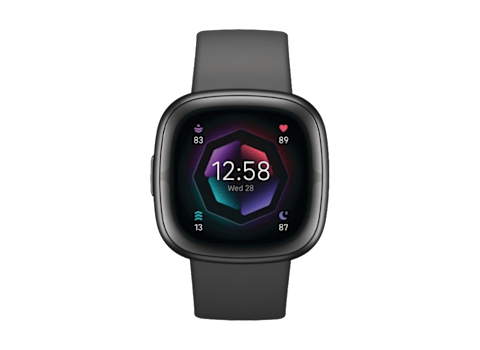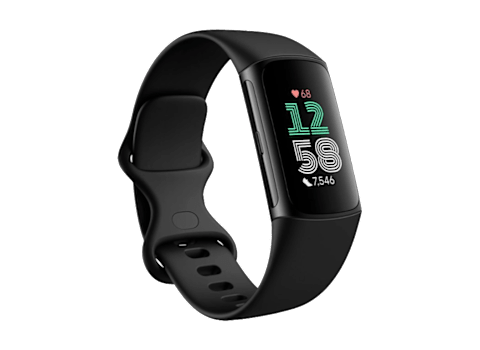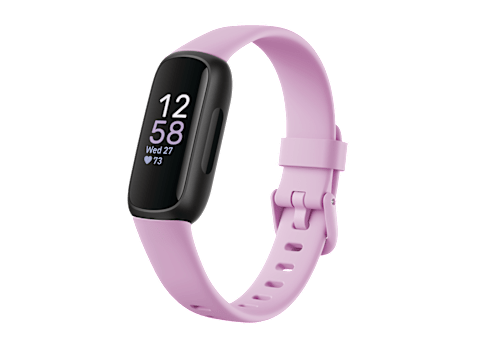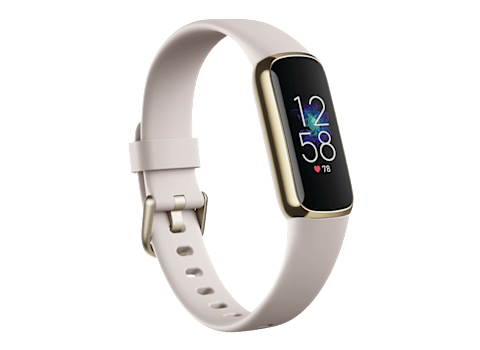¿Qué rastreador de actividad física o reloj inteligente Fitbit deberías comprar?

La línea de productos de Fitbit ofrece una variedad de opciones, desde Fitbit Luxe hasta Versa 4. Aquí te contamos cómo decidir cuál es el mejor modelo para ti.
El Fitbit Versa 4 ofrece GPS integrado y un rendimiento sólido en un reloj inteligente de precio relativamente bajo.
By Courtney Lindwall
¿Estás pensando en comprar un rastreador de actividad física o un reloj inteligente que te ayude a ser más activo en el nuevo año? ¿Quizás incluso lograr un objetivo específico, como correr 5km o mejorar tu sueño? Fitbit, que fue adquirida por Google en 2021, ha sido líder en tecnología portátil durante más de una década y ofrece una variedad de modelos que pueden ayudarte a lograr tus objetivos de salud y fitness. Pero puede ser complicado elegir el modelo adecuado.
La línea de productos de Fitbit se ha ampliado y ahora incluye casi media docena de opciones, incluidos rastreadores de actividad física básicos y relojes inteligentes repletos de funciones con grandes pantallas a todo color. ¿Quieres responder mensajes de texto fácilmente, directamente desde tu muñeca? Sí, tienes opciones. ¿Tienes un presupuesto ajustado o quieres darte un capricho? Te recomendamos modelos en ambos extremos del espectro de precios.
Para ayudarte a limitar tus opciones, hemos elaborado esta guía de las ofertas de la empresa con los detalles sobre las características, la precisión y la selección de aplicaciones. Como Fitbit ahora vive bajo el paraguas de Google, también incluimos el reloj inteligente Google Pixel 3 de gama alta en nuestra guía, que incorpora parte de la tecnología de Fitbit pero funciona con el sistema operativo Wear OS de Google. A diferencia de Fitbit, que puede funcionar tanto con teléfonos Apple como Android, los relojes Pixel solo funcionan con teléfonos Android.
Lo mejor de todo es que puedes confiar en nuestras calificaciones. Todos los artículos probados en nuestros laboratorios se compran al por menor, en las mismas tiendas y sitios que tú. Así es como evitamos recibir un trato especial de los fabricantes. Y nuestros evaluadores someten cada modelo al mismo riguroso protocolo de prueba, para que puedas hacer comparaciones sencillas. Si eres miembro de Consumer Reports, también puedes consultar nuestras calificaciones de rastreadores de actividad física y relojes inteligentes para obtener toda la información sobre todos los modelos.
¿Rastreador de actividad física o reloj inteligente?
En los últimos años, la línea que separa un rastreador de actividad física básico y un reloj inteligente también se ha desdibujado en la gama de productos de Fitbit. Los rastreadores de actividad física suelen estar diseñados para el seguimiento básico de métricas de salud, como los pasos y el sueño, aunque algunos ofrecen sensores y funciones más avanzadas, como el control del ritmo cardíaco y GPS integrado.
En comparación, los relojes inteligentes suelen tener pantallas más grandes con correas intercambiables, sensores más avanzados y más conectividad con el teléfono, como la capacidad de recibir llamadas usando el altavoz integrado del reloj. Pero los relojes inteligentes suelen tener una duración de batería más corta y un precio más elevado.
Piensa en cómo planeas usar tu Fitbit. ¿Solo buscas aumentar tu movimiento diario y hacer un seguimiento de los datos básicos de salud en la aplicación Fitbit? ¿O quieres una conectividad total con tu teléfono inteligente, incluida la capacidad de leer correos electrónicos y responder mensajes de texto fácilmente desde tu muñeca?
Si buscas un rastreador de actividad física más básico: Fitbit ofrece el Charge 6 repleto de funciones, el Inspire 3, más delgado y económico, y el Fitbit Luxe, de aspecto elegante.
Si quieres un reloj inteligente con más funciones: Fitbit ofrece el versátil Versa 4 y el Sense 2, que se centra en el estrés. Dado que Fitbit ahora es propiedad de Google y ciertas funciones se comparten entre las distintas líneas de productos, es posible que también quieras considerar el Google Pixel Watch 3, una oferta premium a la par de un Apple Watch o un Samsung Galaxy Watch, pero que solo se puede emparejar con un teléfono Android. A continuación, analizamos en detalle cada modelo.
Nota: Si buscas un reloj apto para niños con menos funciones y más controles parentales, Fitbit ofrece Fitbit Ace. Hemos analizado los pros y los contras de comprar un reloj inteligente para tu hijo, pero no comparamos aquí el modelo Fitbit Ace en profundidad.
Relojes inteligentes
Pagarás un poco más por un reloj inteligente, pero obtendrás más conectividad con tu teléfono, incluido el acceso a ciertas aplicaciones de terceros, una pantalla más grande y funciones más avanzadas. Sin embargo, los modelos como estos deben cargarse con más frecuencia.
Fitbit Versa 4
The Versa 4 is your best bet if you’re looking for a well-rounded Fitbit with the latest features. For $200, you get all the basics of modern wearable technology, like step counting, heart rate and blood oxygen level monitoring, as well as workout and sleep tracking. The step count is reliably accurate, according to our testing, though the heart rate monitor is less impressive than what you find on other models in our ratings. You also get a few more advanced sensors and analysis through the Fitbit app on things like heart rate variability, stress levels, and sleep health.
The Versa 4 has built-in GPS, which is handy if you want to track the route or mileage of a run while leaving your phone at home. A built-in speaker allows you to take calls right from your wrist via a Bluetooth connection to your smartphone, unlike the Charge 6 or Inspire 3. You can also easily reply to texts using voice transcription or by selecting from pre-written messages. The Versa 4 looks quite similar to the Sense 2. Both have 1.4-inch AMOLED color displays, but the Versa 4 doesn’t offer the Sense 2’s advanced stress-tracking features, including the electrocardiogram (ECG) sensor, which measures the heart’s electrical activity and can alert you to potential abnormalities.
Fitbit Sense 2
The Sense 2 is a Fitbit tracker aimed at stress management. Its range of sensors makes it the most expensive watch in Fitbit’s lineup at $250.
The model can track your heart rate, breathing, and even the minute electrical currents on your skin. That data is analyzed to monitor how your body reacts to stress. The Sense 2 will send you notifications to take breaks or suggest a guided breathing exercise. Within the Fitbit app, you can also pore over your Sleep Profile, which includes advice on how to get better shut-eye based on your own sleep data.
Like watches from Apple and Samsung, the Sense 2 lets you record an electrocardiogram (ECG), measuring the heart’s electrical activity. The device is fairly accurate when it comes to step counting, but it doesn’t do as well as other models when measuring heart rate. Our testers also don’t find it quite as easy to use or as scratch-resistant as other Fitbit models.
The Sense 2 can last six days on one charge, Fitbit says. (We don’t test the battery life claims of smartwatches in our labs.) That’s quite a bit longer than some high-end smartwatches but not as impressive as other models in Fitbit’s lineup, like the Charge 6 or Inspire 3.
Google Pixel Watch 3 (41mm)
If you’re looking for a full-fledged smartwatch that rivals those made by Apple or Samsung, the Pixel Watch 3 might be your best bet. It has seamless compatibility with the Pixel phone and full Google ecosystem, but unlike Fitbit watches, it can’t pair with an iPhone. You can buy the LTE model ($400) if you want cellular connectivity away from your smartphone.
The Pixel Watch 3 offers a robust suite of health features, like automatic workout detection and heart rate variability tracking, as well as daily Readiness and Sleep scores within the Fitbit app. It receives strong scores for ease of use, readability in bright and low light, and heart rate accuracy, though its performance in our scratch resistance testing was not quite as impressive as that of models like the Apple Watch Series 10 or the Samsung Galaxy Watch7.
The battery lasts 24 hours with the always-on display or 36 hours in Battery Saver mode, according to Google. That’s not nearly as long as the multiple days that most Fitbit models can last between charges, which may prevent you from making the most of sleep tracking or battery-draining GPS tracking. And although its Fitbit-driven health features are more versatile than before, they still lag a bit behind those of Apple and Samsung models.
Like all other Fitbit wearables, the Pixel Watch 3 comes with six months of Fitbit Premium, which offers a library of trainer-led workouts and otherwise costs $10 per month.
Rastreadores de actividad física
Estos wearables (o también llamados tecnología ponible) de diseño reducido están diseñados como pulseras con pantallas integradas. Tienen menos conectividad con un teléfono inteligente que un reloj inteligente completo y no tienen la capacidad de conectarse a aplicaciones de terceros. Pero también tienen una mayor duración de la batería y un precio más bajo.
Fitbit Charge 6
If you’re looking for a well-rounded fitness tracker, the Charge 6 is a feature-packed model that performs well at a reasonable price. It’s designed as a lightweight, unobtrusive band with a 1.1-inch color touchscreen. You won’t get all the bells and whistles or the same degree of connectivity to your smartphone that you’d get with a smartwatch, but you do get all the health and fitness essentials: sleep tracking, step counting, heart rate monitoring, and “zone” ratings that tell you how intensely you’re exercising.
Our testers find the step counting and heart rate monitoring to be reliably accurate. Plus, the model has an ECG sensor designed to detect abnormal heart rhythms and an electrodermal activity (EDA) sensor to monitor stress levels.
The Charge 6 can automatically detect and start recording certain workouts, which is handy if you, say, forget to press start at the beginning of your run. Unlike the more pared-down Inspire 3, it has a built-in GPS so that you can track mileage and route without your phone nearby, as well as a few other convenient smartwatch features, like tap-to-pay functionality and turn-by-turn directions with Google Maps. If you don’t want to charge daily, the Charge 6 has an impressive seven-day claimed battery life, which makes it easy to use for nightly sleep tracking.
This model scores well in our testing for ease of use, ease of interaction, versatility, and readability in bright light. Its heart rate monitoring is also very accurate, while its step count is quite accurate.
Fitbit Inspire 3
If you want a simple fitness tracker that’s unobtrusive to wear, the Fitbit Inspire 3 is the slimmest and most lightweight option in Fitbit’s lineup. It has a bright OLED color display, available with pink, orange, and black band options. It also comes with the smallest price tag of any Fitbit model at just $60.
The Inspire 3 gets you all the essentials you’d expect from a wearable: step counting, heart rate monitoring, and sleep tracking. As with other Fitbit models, you also get a more holistic look at your health within the Fitbit app by checking your daily Sleep Score and Stress Management Score, which tells you whether to adjust your movement up or down for the day.
It’s easy to use, with accurate step-counting and heart rate monitoring, our testers report. And if you don’t like charging a device again and again, the Inspire 3 has an impressive claimed battery life of 10 days. That’s significantly longer than that of higher-end smartwatches like the Google Pixel Watch 3 (24 hours).
As far as connectivity to your phone, the Inspire 3 will notify you of calls and texts, but you won’t be able to answer calls directly from the device and you can only send specific “quick response” replies to texts from a set menu. The Inspire 3 also doesn’t have built-in GPS, so you won’t be able to log a specific route on your run or ride without your phone nearby.
Fitbit Luxe
The lightweight Fitbit Luxe is similar to the Fitbit Inspire 3, but it has a more premium, jewelery-like design and a polished stainless steel case. It includes some of the stress-tracking features found on the pricier Sense smartwatch. The Luxe earns high marks for the accuracy of its step count and heart rate monitors. Our testers find the display easy to read in low and bright light, but its tiny size may make it tough for some people to view.
Consumer Reports is an independent, nonprofit organization that works side by side with consumers to create a fairer, safer, and healthier world. CR does not endorse products or services, and does not accept advertising. Copyright © 2025, Consumer Reports, Inc.

